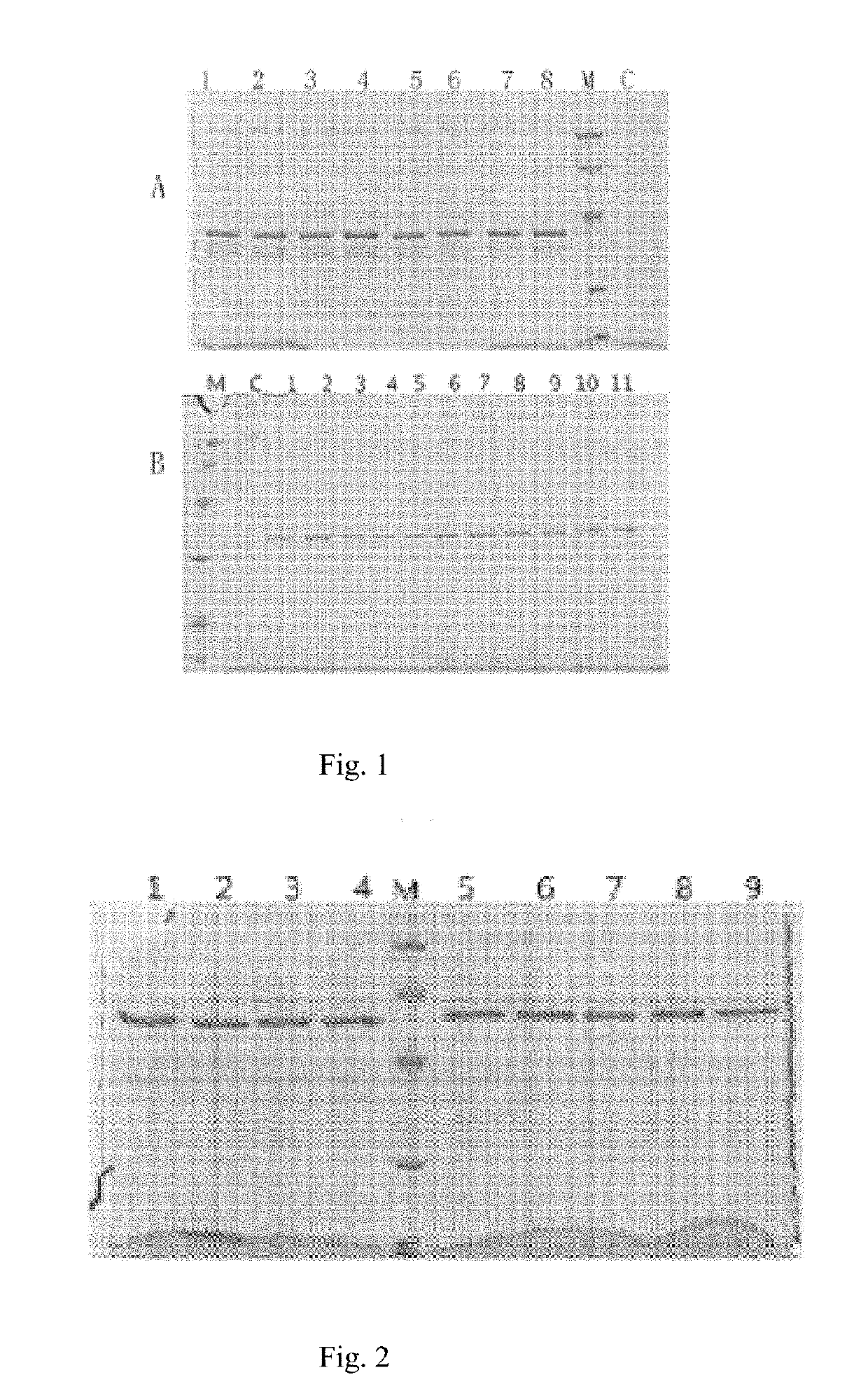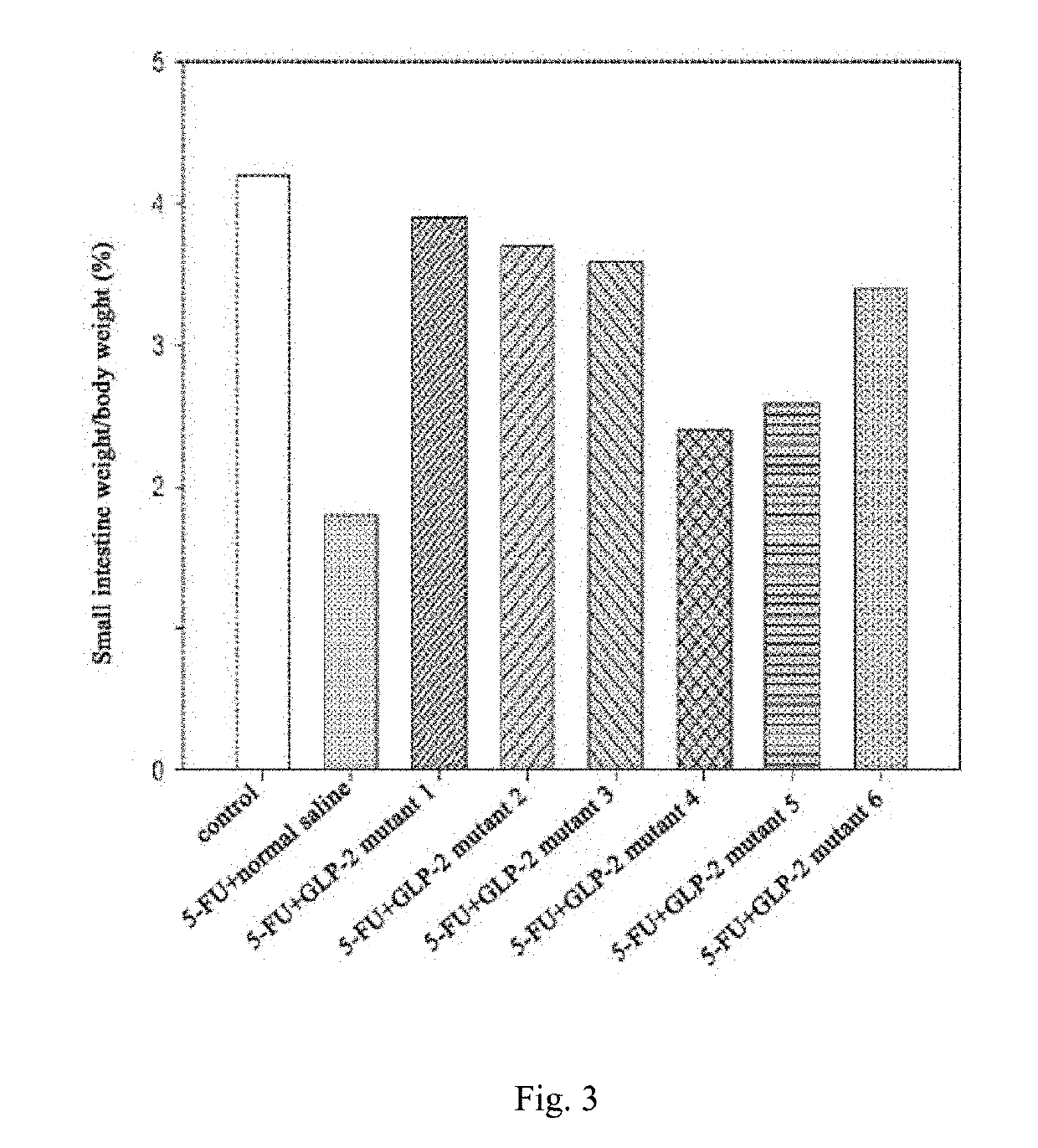Fusion protein for treating intestinal diseases
a technology of fusion protein and intestinal disease, which is applied in the direction of anti-noxious agents, drug compositions, peptide/protein ingredients, etc., can solve the problems of renal clearance, high enzymatic degradation of glp-2, and need to be subcutaneously injected once a day, so as to prevent the loss of glp-2 receptor agonist bioactivity, prevent the loss of glp-2 receptor agonist, and maintain significant activity
- Summary
- Abstract
- Description
- Claims
- Application Information
AI Technical Summary
Benefits of technology
Problems solved by technology
Method used
Image
Examples
example 1
ing and Expression Vector Construction
[0049]The coding genes for GLP-2 mutant, peptide linkers and Fc fragments of human IgG1 and IgG4 were designed according to their amino acid sequences and codon preference in yeasts as shown in Table 1, all of which were obtained through gene synthesis. Complete coding genes for a fusion protein were obtained through amplification with SOE-PCR (splicing by overlap extension, abbreviated as SOE). Those skilled in the art can easily infer the gene sequences from amino acid sequences in Table 1 and design corresponding primers for amplifications. XhoI and EcoRI recognition sites were added in termini of an upstream primer of a GLP-2 mutant gene and a downstream primer of an Fc fragment, respectively. The PCR (Polymerase Chain Reaction) products were cloned into pPIC9 vector for expression of fusion proteins of SEQ ID NO: 9-29. SEQ ID NO:2 was used as a control and obtained through chemical synthesis. Table 2 lists primer sequences for amplifying th...
example 2
nt Protein Acquisition
[0052]A single colony of the above transformed recombinant yeast was inoculated into 10 ml of BMGY liquid medium, cultured at 250 rpm at 30° C. for 24 h, and left to stand overnight. After the supernatant was discarded, 10 ml of a BMMY liquid medium containing 1% methanol was added for inducible expression at 250 rpm at 30° C. Strains with relatively high expression levels were selected as expression strains. Detailed procedures were described in the manufacturer's manual (Pichia Expression Kit. For Expression of Recombinant Proteins in Pichia pastoris. Catalog No. K1710-01) .
[0053]As initial inoculum, high expressing clones obtained through screening were inoculated into YPD fluid medium (Yeast Extract Peptone Dextrose Medium), cultured at 220 rpm at 30° C. for 20-24 h until the OD600 reached 10-20. The initial inoculum was inoculated into a 5 L fermentor with medium previously prepared according to Pichia Fermentation Process Guidelines of Life technologies (...
example 3
otein Extraction and Purification
[0055]The fermentation broth obtained in Example 2 was centrifuged at 8000 rpm at room temperature for 30 min to collect the supernatant. Samples were loaded on a chromatographic column (Diamond Protein A BestChrome, Bestchrom (Shanghai) Biosciences Co. Ltd) pre-equilibrated with buffer solution A (0.5M NaCl, 20 mM PB, pH 7.0). The interested fusion protein bound on the column was eluted with elution buffer B (0.1M Gly-HCl, pH 3.0) after re-equilibrating with the buffer solution A. Neutralization solution (1M Tris-HCl, pH8.0), in the volume of 10% of the eluate volume, was added to adjust the pH, followed by conductivity adjustment with deionized water until the conductivity reaches 4 ms / cm or less. The adjusted eluate was then loaded on a chromatographic column (TOSOH Super Q 650-M) pre-equilibrated with buffer solution A (20 mM PB, pH7.0), followed by re-equilibrating with buffer solution A and eluting with elution buffer B (0.5M NaCl, 20mM PB, pH7...
PUM
| Property | Measurement | Unit |
|---|---|---|
| structure | aaaaa | aaaaa |
| length | aaaaa | aaaaa |
| molecular weight | aaaaa | aaaaa |
Abstract
Description
Claims
Application Information
 Login to View More
Login to View More - R&D
- Intellectual Property
- Life Sciences
- Materials
- Tech Scout
- Unparalleled Data Quality
- Higher Quality Content
- 60% Fewer Hallucinations
Browse by: Latest US Patents, China's latest patents, Technical Efficacy Thesaurus, Application Domain, Technology Topic, Popular Technical Reports.
© 2025 PatSnap. All rights reserved.Legal|Privacy policy|Modern Slavery Act Transparency Statement|Sitemap|About US| Contact US: help@patsnap.com


